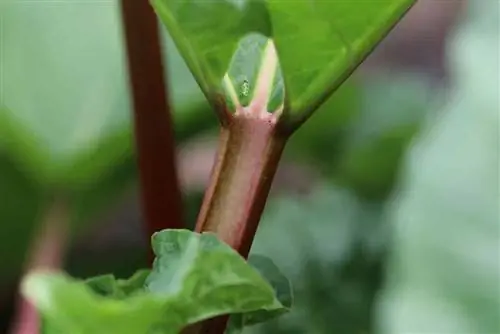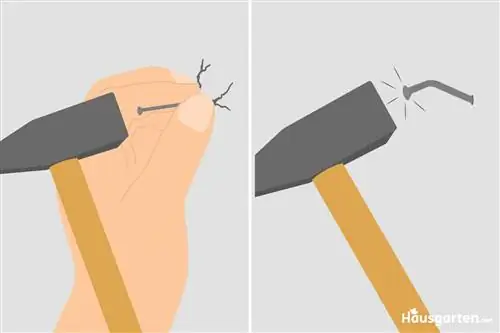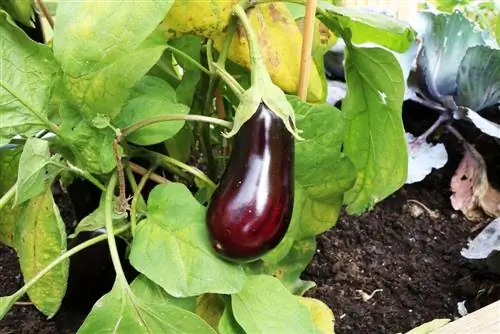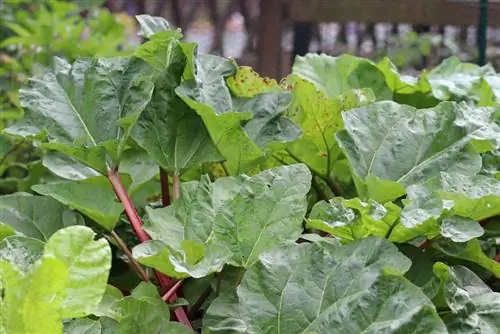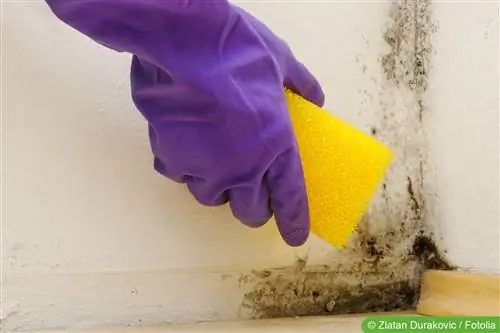- Author admin [email protected].
- Public 2023-12-17 03:39.
- Last modified 2025-06-01 06:48.
Every year the rhubarb season is accompanied by wagging fingers from he alth experts. It is strongly advised not to eat the fruity-sour vegetable sticks raw due to the high content of toxic oxalic acid. We have carefully examined the warnings that ruin our appetite for crunchy, freshly harvested rhubarb every year. This guide sheds light on all raw food fans who are wondering whether uncooked rhubarb is poisonous or not. This is something to keep in mind if you like to eat the refreshing sticks raw.
Low toxic - oxalic acid is the culprit
Rhubarb not only contains valuable vitamins and nutrients. At the same time, the entire plant is permeated with oxalic acid. If the toxic fruit acid gets into the human organism, it hinders the absorption of iron. This process is dangerous for a he althy person in large quantities. However, small children and adults with kidney and heart disease face a he alth risk even after consuming a small dose of oxalic acid. First and foremost, doctors warn that in severe cases damage to the kidneys and heart can occur, including symptoms of paralysis and cardiac arrest.
When assessed cursorily, this circumstance appears dramatic. In fact, oxalic acid only harms he alth in very high quantities and under special, rarely occurring conditions:
- Oxalic acid content in 100 grams of fresh rhubarb: 180 to 765 milligrams
- Poisonous dose for he althy people: from 600 milligrams per kilogram of body weight
Translated to an adult, the scientists' findings mean that in order to suffer poisoning, a person weighing 60 kilos must eat a staggering 36 kilos of raw rhubarb.
Tip:
Oxalic acid attacks tooth enamel. This process can be felt by a furry feeling in the mouth and rough tooth enamel when you eat rhubarb raw or cooked. Please do not brush your teeth immediately, but wait at least 30 minutes. Otherwise, the tooth enamel will be further damaged by the toothbrush.
Eating leaves is forbidden
Oxalic acid is found in the highest concentration in the leaves of a rhubarb plant. With up to 520 milligrams per 100 grams of leaf weight, this high concentration of toxins is questionable even for he althy adults. Therefore, limit your enjoyment of rhubarb to the green or red stalks. Cut off the leaves immediately and dispose of them in the compost. This is easy to do without, because the high oxalic acid content gives the plant's foliage a bitter, very unpleasant taste.
Oxalic acid sets limits on raw consumption
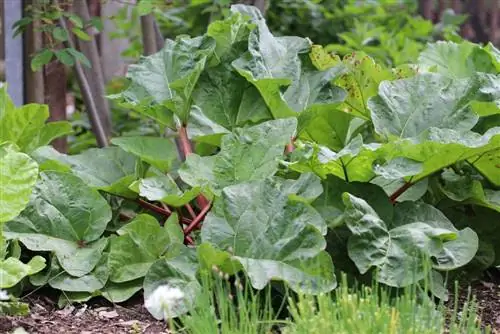
The complete all-clear for consuming raw rhubarb cannot be given even to he althy adults. There's nothing wrong with enjoying one or two sticks fresh from the bed. In addition, raw consumption should not be allowed in one day. In the organism, oxalic acid combines with the body's own calcium to form crystals. These accumulate in proportion to the amount in which you eat rhubarb raw. Sooner or later, kidney or bladder stones can form from the amount deposited, even in he althy people. Anyone who is already struggling with this condition should strictly avoid eating the sour vegetable sticks raw.
Peeling reduces toxic concentration
Smooth skins indicate rhubarb that is ready to harvest. Now it's tempting to eat the first stalks raw right in the bed. If you have concerns about the oxalic acid contained, remove the peels. The toxin content in the pulp is significantly lower than in the peel and leaves. In addition, gourmets advocate always eating rhubarb without the peel. How to do it right:
- Cut off poles with smooth shells close to the ground in the bed
- Cut off the leaves and throw them in the compost
- Clean rhubarb stalks under running water or wipe with a damp cloth
- Use the kitchen knife to grasp the peel at one end and slowly peel it off
Exceptionally, red-stemmed rhubarb varieties can be eaten raw together with the tender peel in April and May because they contain only a little oxalic acid at the early harvest time. Green-stemmed varieties are always peeled because they have a higher toxic content throughout the season.
No connection between flowers and oxalic acid content
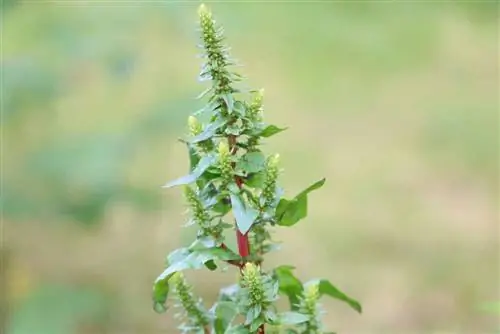
When rhubarb plants put on their magnificent flower dress in April or May, rumors circulate every year about a connection between flowers and oxalic acid. The misconception persists that the concentration of oxalic acid increases parallel to the progress of the flowering period. Scientists have credibly refuted this theory. Enjoy the beautiful flowers and don't let the misconception reduce the already very short harvest time.
Tip:
When cooked, rhubarb loses much of its oxalic acid. Ideally serve the fruity vegetables in combination with vanilla pudding or other dairy products. The calcium it contains converts the remaining residues of oxalic acid into insoluble calcium oxalate, which is excreted in the normal way.
From June onwards, do not consume raw or cooked
The harvest window for rhubarb closes on June 24th, St. John's Day. This is recommended for several reasons. The oxalic acid content primarily accumulates in proportion to the course of the growing season. At the beginning of the harvest season, peeled, raw rhubarb stalks only contain a small amount of fruit acid. As growth and the season progress, the alarming level increases noticeably. From the end of June, eating rhubarb raw and cooked is also risky for he althy adults.
Tip:
Home gardeners who grow their own rhubarb stop harvesting at the end of June for cultural reasons. Give the plants the opportunity to regenerate sufficiently until the beginning of winter. Without this phase of undisturbed growth, the mighty perennial will significantly lose its productivity.
Conclusion
He althy adults can safely eat one or two rhubarb sticks raw per day. If the desire for the invigorating, sour fruit pleasure is not satisfied, the vegetables should be cooked. Small children and adults with poor he alth consistently avoid eating raw foods. The plant contains plenty of oxalic acid, which in large quantities hinders the absorption of iron, can cause kidney and bladder stones and can even damage the heart. In addition, the fruit acid aggressively attacks the tooth enamel. When prepared with boiling water, most of the fruit acid dissolves. This applies at least to the recommended harvest period from May to the end of June. Starting on St. John's Day, a worrying level of toxic oxalic acid has built up in raw and cooked rhubarb stalks, making consumption in any form a he alth risk.

